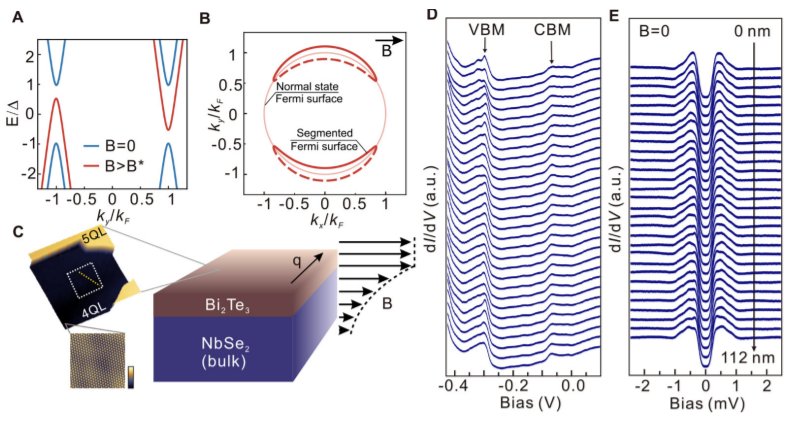A team of researchers from China and the United States has recreated gapless superconducting quasiparticles on fragmented Fermi surfaces of bismuth telluride (Bi2Te3) thin films. An in-plane magnetic field leads to finite-momentum Cooper pairing on the topological surface states of bismuth telluride.
 Image Credit: Zhu, Z., et.al., (2021) Discovery of segmented Fermi surface induced by Cooper pair momentum. [online] Science. Available at: https://www.science.org/doi/10.1126/science.abf1077
Image Credit: Zhu, Z., et.al., (2021) Discovery of segmented Fermi surface induced by Cooper pair momentum. [online] Science. Available at: https://www.science.org/doi/10.1126/science.abf1077
The bismuth telluride was grown by molecular beam epitaxy on top of an s-wave superconducting crystal, niobium diselenide (NbSe2). Majorana mode (Bogoliubov) quasiparticles may have novel applications in quantum computing as superconducting qubits.
Cooper Pairing and Quasiparticles
According to condensed matter theory, the transition of a metal to a superconducting state depends on the ability of its electrons to condense into the lowest energy state. However, because electrons are fermions, they are prevented by the Pauli exclusion principle from occupying the same quantum state. However, the physicist Herbert Fröhlich was the first to suggest that electrons may act as pairs, interacting with lattice vibrations in metals.
In fact, quasiparticles emerge in complex many-body systems when the motions of particles are disturbed by their interactions with electrons and atomic nuclei. Electron holes, for example, are positively charged quasiparticles caused by the aggregate motion of electrons in the valence band of a semiconductor. In other examples, phonons are derived from the vibrations of atoms and plasmons from plasma oscillations.
Electron-phonon interactions in metals cause arbitrarily small attractions between pairs of electrons resulting in Cooper pairs. This pair has lower energy than the Fermi energy. The Fermi energy represents the difference between the Fermi level and the lowest occupied single-particle state, at absolute zero. The Fermi level, in turn, represents the top energy level at absolute zero. Thus, the Cooper pair is bound and is not free flowing electrons.
The electrons do not have to be in close proximity and may be hundreds of nanometers apart, a distance greater than average inter-electron separations. Thus, many Cooper pairs can occupy the same state. Electrons are fermions (spin ½), but the total spin of a Cooper pair is 0 or 1, thus making them composite bosons.
Crucially, there is no restriction on the number of bosons that can occupy the same quantum state. When bosons are cooled to near absolute zero, they condense into the lowest energy state. In such a state, they are superconductors. A Cooper pair is also known as a Bardeen–Cooper–Schrieffer pair. In 1972, John Bardeen, Leon Cooper, and John Schrieffer were awarded the Nobel Prize in Physics.
Recreating Gapless Superconducting States
In condensed matter physics, the Fermi surface is an abstract construct defining the allowable energy levels of electrons in solids such as metals. They define the thermal, electrical, and magnetic properties of crystalline materials.
In normal metals, the electron order is gapless (electron energy levels are filled up to the Fermi surface). They are bound in valence bands or occupy conduction bands within which they are free to move. Each band represents a given energy level.
The proximity effect occurs when a non-conducting material is placed in contact with a superconducting material. At the interface between the superconductor and non-conducting metal, the electron order does not change abruptly from one to the other. Instead, the Cooper state of the superconducting material is carried over to the conventional material. In such an event, weak supercurrents are observed in the conventional material.
The Chinese and U.S. team induced Bogoliubov quasiparticles that are superpositions of the excitations of negatively charged electrons and positively charged “electron holes.” Crucially, therefore, these quasiparticles are fermions and not bosons as in Cooper pair superconductors. These so-called Majorana fermions promise novel applications in superconducting qubits for quantum computing.
References and Further Reading
Zhu, Z., et.al., (2021) Discovery of segmented Fermi surface induced by Cooper pair momentum. [online] Science. Available at: https://www.science.org/doi/10.1126/science.abf1077
Disclaimer: The views expressed here are those of the author expressed in their private capacity and do not necessarily represent the views of AZoM.com Limited T/A AZoNetwork the owner and operator of this website. This disclaimer forms part of the Terms and conditions of use of this website.